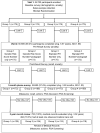Randomized trial finds that prostate cancer genetic risk score feedback targets prostate-specific antigen screening among at-risk men
- PMID: 27433786
- PMCID: PMC5247411
- DOI: 10.1002/cncr.30162
Randomized trial finds that prostate cancer genetic risk score feedback targets prostate-specific antigen screening among at-risk men
Abstract
Background: Prostate-specific antigen (PSA) screening may reduce death due to prostate cancer but leads to the overdiagnosis of many cases of indolent cancer. Targeted use of PSA screening may reduce overdiagnosis. Multimarker genomic testing shows promise for risk assessment and could be used to target PSA screening.
Methods: To test whether counseling based on the family history (FH) and counseling based on a genetic risk score (GRS) plus FH would differentially affect subsequent PSA screening at 3 months (primary outcome), a randomized trial of FH versus GRS plus FH was conducted with 700 whites aged 40 to 49 years without prior PSA screening. Secondary outcomes included anxiety, recall, physician discussion at 3 months, and PSA screening at 3 years. Pictographs versus numeric presentations of genetic risk were also evaluated.
Results: At 3 months, no significant differences were observed in the rates of PSA screening between the FH arm (2.1%) and the GRS-FH arm (4.5% with GRS-FH vs. 2.1% with FH: χ2 = 3.13, P = .077); however, PSA screening rates at 3 months significantly increased with given risk in the GRS-FH arm (P = .013). Similar results were observed for discussions with physicians at 3 months and PSA screening at 3 years. Average anxiety levels decreased after the individual cancer risk was provided (P = .0007), with no differences between groups. Visual presentation by pictographs did not significantly alter comprehension or anxiety.
Conclusions: This is likely the first randomized trial of multimarker genomic testing to report genomic targeting of cancer screening. This study found little evidence of concern about excess anxiety or overuse/underuse of PSA screening when multimarker genetic risks were provided to patients. Cancer 2016;122:3564-3575. © 2016 American Cancer Society.
Keywords: genetic counseling; genetic risk score; genetic testing; prostate cancer; prostate-specific antigen (PSA) screening; randomized controlled trial.
© 2016 American Cancer Society.
Figures






Similar articles
-
Single-Nucleotide Polymorphism-Based Genetic Risk Score and Patient Age at Prostate Cancer Diagnosis.JAMA Netw Open. 2019 Dec 2;2(12):e1918145. doi: 10.1001/jamanetworkopen.2019.18145. JAMA Netw Open. 2019. PMID: 31880795 Free PMC article.
-
Adding genetic risk score to family history identifies twice as many high-risk men for prostate cancer: Results from the prostate cancer prevention trial.Prostate. 2016 Sep;76(12):1120-9. doi: 10.1002/pros.23200. Epub 2016 May 16. Prostate. 2016. PMID: 27197965 Free PMC article. Clinical Trial.
-
A positive family history as a risk factor for prostate cancer in a population-based study with organised prostate-specific antigen screening: results of the Swiss European Randomised Study of Screening for Prostate Cancer (ERSPC, Aarau).BJU Int. 2016 Apr;117(4):576-83. doi: 10.1111/bju.13310. Epub 2015 Oct 6. BJU Int. 2016. PMID: 26332304 Free PMC article. Clinical Trial.
-
Prostate cancer screening with prostate-specific antigen (PSA) test: a systematic review and meta-analysis.BMJ. 2018 Sep 5;362:k3519. doi: 10.1136/bmj.k3519. BMJ. 2018. PMID: 30185521 Free PMC article.
-
Detection of prostate cancer: the impact of the European Randomized Study of Screening for Prostate Cancer (ERSPC).Can J Urol. 2005 Feb;12 Suppl 1:2-6; discussion 92-3. Can J Urol. 2005. PMID: 15780157 Review.
Cited by
-
Prostate cancer screening-when to start and how to screen?Transl Androl Urol. 2018 Feb;7(1):34-45. doi: 10.21037/tau.2017.12.25. Transl Androl Urol. 2018. PMID: 29594018 Free PMC article. Review.
-
The GenoVA study: Equitable implementation of a pragmatic randomized trial of polygenic-risk scoring in primary care.Am J Hum Genet. 2023 Nov 2;110(11):1841-1852. doi: 10.1016/j.ajhg.2023.10.001. Am J Hum Genet. 2023. PMID: 37922883 Free PMC article. Clinical Trial.
-
Clarifying the Trade-Offs of Risk-Stratified Screening for Prostate Cancer: A Cost-Effectiveness Study.Am J Epidemiol. 2021 Oct 1;190(10):2064-2074. doi: 10.1093/aje/kwab155. Am J Epidemiol. 2021. PMID: 34023874 Free PMC article.
-
Acceptability and perceptions of personalised risk-based cancer screening among health-care professionals and the general public: a systematic review and meta-analysis.Lancet Public Health. 2025 Feb;10(2):e85-e96. doi: 10.1016/S2468-2667(24)00278-0. Lancet Public Health. 2025. PMID: 39909697 Free PMC article.
References
-
- Moyer VA, on behalf of the U.S. Preventive Services Task Force Screening for Prostate Cancer: U.S. Preventive Services Task Force Recommendation Statement. Ann Intern Med. 2012 Jul 17;157(2):120–134. - PubMed
-
- American Urological Association. accessed July 1, 2015. http://www.auanet.org/education/policy-statements/early-detection-of-pro....
-
- American Cancer Society. accessed February 25, 2016. http://www.cancer.org/cancer/prostatecancer/detailedguide/prostate-cance....
-
- European Association of Urology Guidelines on Prostate Cancer. accessed February 25, 2016. http://uroweb.org/guideline/prostate-cancer/
-
- Schröder FH. Landmarks in prostate cancer screening. BJU Int. 2012 Oct;110(Suppl 1):3–7. - PubMed
Grants and funding
LinkOut - more resources
Full Text Sources
Other Literature Sources
Research Materials
Miscellaneous

